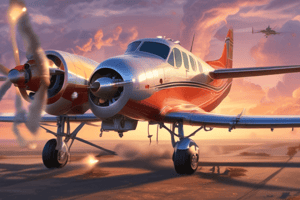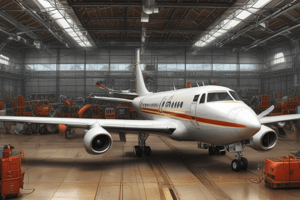Podcast
Questions and Answers
What is the primary purpose of trim adjustments in aircraft?
What is the primary purpose of trim adjustments in aircraft?
- To ensure passenger safety and comfort
- To maintain level flight without constant control input (correct)
- To adjust fuel consumption
- To reposition cargo within the allowable range
Which technique requires careful planning to avoid unbalancing the aircraft further?
Which technique requires careful planning to avoid unbalancing the aircraft further?
- Fuel management (correct)
- Trim adjustments
- Passenger management
- Cargo restraint and management
What is the primary consideration when asking passengers to change seats in smaller aircraft?
What is the primary consideration when asking passengers to change seats in smaller aircraft?
- Weight distribution and balance
- Safety and comfort (correct)
- Cargo restraint and management
- Fuel consumption and efficiency
What is essential for pilots to have when managing in-flight weight and balance?
What is essential for pilots to have when managing in-flight weight and balance?
What is the ultimate goal of in-flight weight and balance management?
What is the ultimate goal of in-flight weight and balance management?
What is necessary for pilots to be proficient in making in-flight adjustments?
What is necessary for pilots to be proficient in making in-flight adjustments?
What is crucial for pilots to have when it comes to weight and balance management?
What is crucial for pilots to have when it comes to weight and balance management?
What is the primary benefit of proactive weight and balance management?
What is the primary benefit of proactive weight and balance management?
What is essential for pilots to consider when making in-flight adjustments?
What is essential for pilots to consider when making in-flight adjustments?
What is the ultimate result of effective weight and balance management?
What is the ultimate result of effective weight and balance management?
Trim adjustments can be used to alter the aircraft's structural integrity.
Trim adjustments can be used to alter the aircraft's structural integrity.
Fuel management involves reducing fuel consumption to minimize weight.
Fuel management involves reducing fuel consumption to minimize weight.
Cargo restraint and management is critical only during takeoff and landing.
Cargo restraint and management is critical only during takeoff and landing.
Passenger management involves rearranging passengers to reduce the aircraft's weight.
Passenger management involves rearranging passengers to reduce the aircraft's weight.
In-flight weight and balance management is only necessary for large commercial aircraft.
In-flight weight and balance management is only necessary for large commercial aircraft.
Trim adjustments can be used to compensate for changes in wind direction.
Trim adjustments can be used to compensate for changes in wind direction.
In-flight adjustments require pilots to constantly monitor the aircraft's weight and balance state.
In-flight adjustments require pilots to constantly monitor the aircraft's weight and balance state.
Fuel management is only necessary for long-distance flights.
Fuel management is only necessary for long-distance flights.
Cargo restraint and management is the primary method of in-flight weight and balance management.
Cargo restraint and management is the primary method of in-flight weight and balance management.
Pilots must be able to predict how changes will affect stability and performance to make effective in-flight adjustments.
Pilots must be able to predict how changes will affect stability and performance to make effective in-flight adjustments.
How do trim adjustments contribute to maintaining level flight?
How do trim adjustments contribute to maintaining level flight?
What is the underlying principle of fuel management in maintaining weight and balance?
What is the underlying principle of fuel management in maintaining weight and balance?
What is the primary objective of cargo restraint and management in maintaining weight and balance?
What is the primary objective of cargo restraint and management in maintaining weight and balance?
Why is passenger management more effective in smaller aircraft?
Why is passenger management more effective in smaller aircraft?
What is the key to making effective in-flight adjustments?
What is the key to making effective in-flight adjustments?
Why is it essential for pilots to be proactive about weight and balance management?
Why is it essential for pilots to be proactive about weight and balance management?
What is the relationship between weight and balance management and aircraft stability?
What is the relationship between weight and balance management and aircraft stability?
How do in-flight adjustments impact aircraft performance?
How do in-flight adjustments impact aircraft performance?
What is the ultimate result of effective in-flight weight and balance management?
What is the ultimate result of effective in-flight weight and balance management?
Why is it important for pilots to have a thorough pre-flight plan for managing in-flight weight and balance?
Why is it important for pilots to have a thorough pre-flight plan for managing in-flight weight and balance?
Flashcards are hidden until you start studying
Study Notes
In-Flight Weight and Balance Management
- In-flight weight and balance adjustments are crucial for maintaining aircraft stability and control during unforeseen scenarios.
- Factors like fuel consumption, cargo shifts, or passenger movements can affect the center of gravity (CG) and require quick thinking and adaptability from pilots.
Importance of In-Flight Weight and Balance Adjustments
- Aviation is unpredictable, and recognizing unforeseen scenarios necessitates a pilot's quick thinking and adaptability to implement immediate corrective strategies.
- Transferring or shifting loads during flight is a primary tool in weight management arsenal, and modern aircraft are equipped with systems that allow such adjustments relatively easily.
Methods for Adjusting Center of Gravity
- Re-securing cargo and reseating passengers when necessary can be effective in adjusting the CG.
- Effective use of aircraft systems to adjust fuel distribution is critical, as changes in fuel weight affect balance substantially during flight.
- Techniques like fuel jettisoning or selecting specific tanks from which to draw fuel can be lifesaving maneuvers in critical situations.
Mitigation Strategies for Weight Shifts
- Maintaining aircraft control and restoring stability is the first priority when dealing with weight shifts.
- Monitoring flight instruments for unusual readings, communicating and ascertaining the cause of the shift, and executing corrective actions are essential.
- Adjusting trim, redefining the flight path, or redistributing the load are possible corrective actions.
Case Examples and Best Practices
- Historical incidents like Air Midwest Flight 5481 highlight the importance of weight and balance management.
- Breaking down such cases develops best practices to avoid repeat scenarios.
- Regularly monitoring weight distribution, ensuring all items are secure, and anticipating potential shifts are crucial for flight safety.
Pilot Actions for Weight Shifts
- Control the aircraft and restore stability.
- Monitor flight instruments for unusual readings.
- Communicate and ascertain the cause of the shift.
- Execute corrective actions such as adjusting trim, redefining the flight path, or redistributing the load.
In-Flight Management Techniques
- Understanding how load distribution affects the aircraft's center of gravity (CG) is essential.
- Pilots must be aware of their aircraft's CG limits, provided in the Aircraft Flight Manual (AFM), and ensure the CG remains within these limits throughout the flight.
- Strategies for in-flight weight and balance adjustments include trim adjustments, fuel management, cargo restraint and management, and passenger management.
Importance of In-Flight Weight and Balance Adjustments
- Unpredictable factors like fuel consumption, cargo shifts, or passenger movements can alter the center of gravity, making adjustments crucial for maintaining stability during flight.
- Pilots must be prepared to implement immediate corrective strategies, requiring quick thinking and adaptability.
Techniques for In-Flight Weight Adjustment
- Load transferring or shifting during flight to adjust the center of gravity.
- Effective use of aircraft systems to adjust fuel distribution, including fuel jettisoning or selecting specific tanks to draw fuel from.
- Mitigating the adverse balance effects from consumables usage, like food and beverages, through meticulous management and regular calculations.
Managing Unexpected Weight Shifts
- Safety protocols for in-flight weight management are crucial in maintaining control during unexpected scenarios.
- Pilot actions for unexpected passenger or cargo movement include following set safety protocols to ensure safety and maintain control.
In-Flight Weight and Balance Documentation
- Accurate records of changes made during flight are essential for safety and regulatory compliance.
Real-Time Corrections
- Examples of pilots successfully navigating emergency situations by implementing corrective strategies and adjusting weight distribution.
- Analyzing historical incidents, like Air Midwest Flight 5481, to develop best practices and avoid repeat scenarios.
Immediate Pilot Actions
- Control the aircraft and restore stability.
- Monitor flight instruments for unusual readings.
- Communicate and determine the cause of the shift.
- Execute corrective actions: adjust trim, redefine the flight path, or redistribute the load.
Key Factors in In-Flight Adjustments
- Understanding how load distribution affects the aircraft's center of gravity (CG).
- Awareness of the aircraft's CG limits, provided in the Aircraft Flight Manual (AFM).
- Ensuring the CG remains within limits throughout the flight.
Weight Shifting and Moments
- Weight shifting can occur due to passenger movement, cargo shifts, or fuel burn-off.
- These shifts affect the aircraft's moments, which are calculated by multiplying the weight of an item by its arm (distance from a reference datum).
- Changes in weight or arm can alter the total moments and thus the CG position.
In-Flight Weight and Balance Management
- Maintaining a precise equilibrium is crucial, and mitigating the adverse balance effects from consumables usage is part of it.
- Real-time corrections are paramount when addressing unexpected center of gravity displacement.
Importance of In-Flight Weight and Balance
- The relationship between weight, moments, and the center of gravity (CG) is fundamental to how an aircraft flies.
- If this delicate balance is disrupted in-flight, a pilot has to make immediate adjustments.
- A shift in the CG can make the aircraft unstable, prone to stalling or difficult to control.
Mitigation Strategies
- Adjusting trim is the first line of defense, helping to counteract any changes and maintain level flight.
- Altering the flight path, perhaps even landing earlier than planned, may be necessary to ensure safety.
- Communication with the crew and passengers is paramount.
Pilot Actions in Case of Weight Shift
- Control the aircraft and restore stability.
- Monitor flight instruments for unusual readings.
- Communicate and ascertain the cause of the shift.
- Execute corrective actions: adjust trim, redefine the flight path, or redistribute the load.
Load Distribution and Center of Gravity
- The load distribution affects the aircraft's center of gravity (CG).
- The CG is the point at which an aircraft would balance if suspended.
- Pilots must be aware of their aircraft's CG limits, which are provided in the Aircraft Flight Manual (AFM).
Causes of Weight Shifting
- Passengers moving within the cabin.
- Cargo shifting during maneuvers.
- Fuel burn-off changing the weight distribution.
Managing In-Flight Weight and Balance
- Trim adjustments can counteract changes in moments.
- Fuel management involves selectively using fuel from different tanks to influence the weight distribution.
- Cargo restraint and management can help maintain a favorable CG.
- Passenger management, such as asking passengers to change seats, can be an effective way to adjust the CG.
Pre-Flight Planning
- Understanding the initial loading of the aircraft.
- Planning for fuel consumption.
- Having strategies in place for potential in-flight adjustments.
Studying That Suits You
Use AI to generate personalized quizzes and flashcards to suit your learning preferences.



